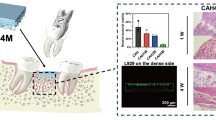Abstract
Although commercially-available poly(methyl methacrylate) bone cement is widely used in total joint replacements, it has many shortcomings, a major one being that it does not osseointegrate with the contiguous structures. We report on the in vitro evaluation of the biocompatibility of modified formulations of the cement in which a high loading of hydroxyapatite (67 wt/wt%), an extra amount of benzoyl peroxide, and either 0.1 wt/wt% functionalized carbon nanotubes or 0.5 wt/wt% graphene oxide was added to the cement powder and an extra amount of dimethyl-p-toluidiene was added to the cement’s liquid monomer. This evaluation was done using mouse L929 fibroblasts and human Saos-2 osteoblasts. For each combination of cement formulation and cell type, there was high cell viability, low apoptosis, and extensive spread on disc surfaces. Thus, these two cement formulations may have potential for use in the clinical setting.









Similar content being viewed by others
References
Lewis G. Alternative acrylic bone cement formulations for cemented arthroplasties: present status, key issues, and future prospects. J Biomed Mater Res B Appl Biomater. 2008;84B:301–19.
Bauer TW, Schils J. The pathology of total joint arthroplasty. Skelet Radiol. 1999;28:483–97.
Barrack RL. Early failure of modern cemented stems. J Arthroplasty. 2000;15:1036–50.
Sinnett-Jones PE, Browne M, Moffat AJ, Jeffers JRT, Saffari N, Buffiere JY, Sinclair I. Crack initiation processes in acrylic bone cement. J Biomed Mater Res A. 2009;89A:1088–97.
Renteria-Zamarron D, Cortes-Hernandez DA, Bretado-Aragon L, Ortega-Lara W. Mechanical properties and apatite-forming ability of PMMA bone cements. Mater Des. 2009;30:3318–24.
Lewis G. Properties of acrylic bone cement: state of the art review. J Biomed Mater Res Part B: Appl Biomater. 1997;38:155–82.
Liu-Snyder P, Webster TJ. Developing a new generation of bone cements with nanotechnology. Curr Nanosci. 2008;4:111–8.
Novoselov KS, Geim AK, Morozov SV, Jiang D, Zhang Y, Dubonos SV, Grigorieva IV, Firsov AA. Electric field effect in atomically thin carbon films. Science. 2004;306:666–9.
Wei DC, Liu YQ. Controllable synthesis of graphene and its applications. Adv Mater. 2010;22:3225–41.
Soldano C, Mahmood A, Dujardin E. Production, properties and potential of graphene. Carbon. 2010;48:2127–50.
Compton OC, Nguyen ST. Graphene oxide, highly reduced grapheme oxide, and graphene: versatile building blocks for carbon-based materials. Small. 2010;6:711–23.
Zanello LP, Zhao B, Hu H, Haddon RC. Bone cell proliferation on carbon nanotubes. Nano Lett. 2006;6:562–7.
Lam CW, James JT, McCluskey R, Hunter RL. Pulmonary toxicity of single-wall carbon nanotubes in mice 7 and 90 days after intratracheal instillation. Toxicol Sci. 2004;77:126–34.
Zhang YB, Ali SF, Dervishi E, Xu Y, Li ZR, Casciano D, Biris AS. Cytotoxicity effects of graphene and single-wall carbon nanotubes in neural phaeochromocytoma-derived PC12 cells. ACS Nano. 2010;4:3181–6.
Agarwal S, Zhou XZ, Ye F, He QY, Chen GCK, Soo J, Boey F, Zhang H, Chen P. Interfacing live cells with nanocarbon substrates. Langmuir. 2010;26:2244–7.
Goncalves G, Cruz SMA, Ramalho A, Gracio J, Marques PAAP. Graphene oxide versus functionalized carbon nanotubes as a reinforcing agent in a PMMA/HA bone cement. Nanoscale. 2012;4:2937–45.
Singh MK, Shokuhfar T, de Almeida Gracio JJ, de Mendes Sousa AC, Da Fonte Fereira JM, Garmestani H, Ahzi S. Hydroxyapatite modified with carbon-nanotube-reinforced poly(methyl methacrylate): a nanocomposite material for biomedical applications. Adv Funct Mater. 2008;18:694–700.
Owens DK, Wendt RC. Estimation of the surface free energy of polymers. J Appl Polym Sci. 1969;13:1741–7.
Dowling DP, Miller IS, Ardhaoui M, Gallagher WM. Effect of surface wettability and topography on the adhesion of osteosarcoma cells on plasma-modified polystyrene. J Biomater Appl. 2011;26:327–47.
Rüttermann S, Trellenkamp T, Bergmann N, Raab WHM, Ritter H, Janda R. A new approach to influence contact angle and surface free energy of resin-based dental restorative materials. Acta Biomater. 2011;7:1160–5.
Singh MK, Gracio J, LeDuc P, Goncalves PP, Marques PAAP, Goncalves G, Marques F, Silva VS, Capelae Silva F, Reis J, Potes J, Sousa A. Integrated biomimetic carbon nanotube composites for in vivo systems. Nanoscale. 2010;2:2855–63.
Anselme K. Osteoblast adhesion on biomaterials. Biomaterials. 2000;21:667–81.
Lai Y, Xie C, Zhang Z, Lu W, Ding J. Design and synthesis of a potent peptide containing both specific and non-specific cell-adhesion motifs. Biomaterials. 2010;31:4809–17.
Cicuendez M, Izquierdo-Barba I, Portoles MT, Vallet-Regi M. Biocompatibility and levofloxacin delivery of mesoporous materials. Eur J Pharm Biopharm. 2013;84:115–24.
Alcaide M, Serrano MC, Pagani R, Sanchez-Salcedo S, Nieto A, Vallet-Regi M, Portoles MT. L929 fibroblast and Saos-2 osteoblast response to hydroxyapatite-beta TCP/agarose biomaterial. J Biomed Mater Res A. 2009;89A:539–49.
Alcaide M, Serrano M-C, Pagani R, Sanchez-Salcedo S, Vallet-Regi M, Portoles MT. Biocompatibility markers for the study of interactions between osteoblasts and composite biomaterials. Biomaterials. 2009;30:45–51.
Hench LL. Bioceramics–from concept to clinic. J Am Ceram Soc. 1991;74:1487–510.
Acknowledgments
Gil Gonçalves thanks the Fundação para a Ciência e Tecnologia (FCT) for the PostDoc grant (SFRH/BDP/84419/2012). This study was co-financed by QREN, programme Mais Centro-Programa Operacional Regional do Centro and União Europeia/Fundo Europeu de Desenvolvimento Regional, project Biomaterials for Regenerative Medicine (CENTRO-07-ST24-FEDER-002030). This study was supported by research grants from Comunidad de Madrid (S2009/MAT-1472). The authors thank the staff of the Cytometry and Fluorescence Microscopy Centre at the Universidad Complutense de Madrid (Spain). Financial support by the CICYT, Spain (Project MAT2008-00736), and Comunidad Autónoma de Madrid, Spain (Project S2009/MAT-1472) is gratefully acknowledged.
Author information
Authors and Affiliations
Corresponding authors
Rights and permissions
About this article
Cite this article
Gonçalves, G., Portolés, MT., Ramírez-Santillán, C. et al. Evaluation of the in vitro biocompatibility of PMMA/high-load HA/carbon nanostructures bone cement formulations. J Mater Sci: Mater Med 24, 2787–2796 (2013). https://doi.org/10.1007/s10856-013-5030-2
Received:
Accepted:
Published:
Issue Date:
DOI: https://doi.org/10.1007/s10856-013-5030-2




